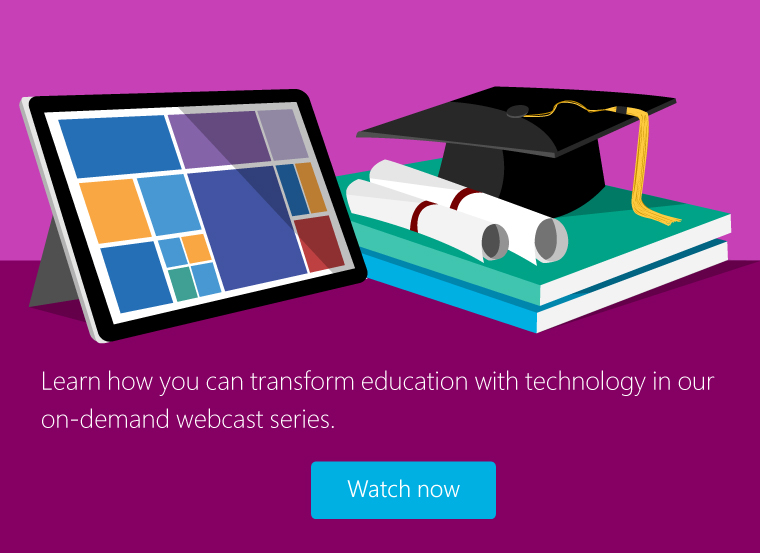
How Omaha Schools rethinks student learning and teacher coaching
| Focus on: Empowering educators, optimizing operations |
Compared to many other small regional districts, Omaha Public Schools lagged in technology adoption. For OPS, being years behind in technology solutions meant bogged down processes and outdated practices.
Recognizing the need for change, the district’s Executive Director of Information Management Services, Rob Dickson, wanted to not only optimize and streamline operations for his community, he wanted to inspire and empower educators to drive real change in their classrooms.
“The district was ripe for change in a lot of different areas,” explains Dickson. “We really hadn’t taken on a cloud—or even a hybrid—strategy as far as data or computing. One of the first things that happened when I came into the district was the introduction of Office 365.”
Little did they know, that first introduction of Office 365 would lead to sustainable change for the district, including smarter data insights, enhanced data management, reimagined teacher coaching, and reinvigorated classroom environments.
This is a real story of digital transformation.
Platform for a transformationWith 80 schools and roughly 51,000 students, Omaha Public Schools represents the largest district in the Cornhusker state. As part of a five-year strategic plan, OPS passed a $421 million bond issue—the largest in state history—to further prioritize their commitment to technology. This motion folds in the latest Microsoft solutions to drive digital citizenship through professional learning across every level of the district, from students and parents to teachers and administration.
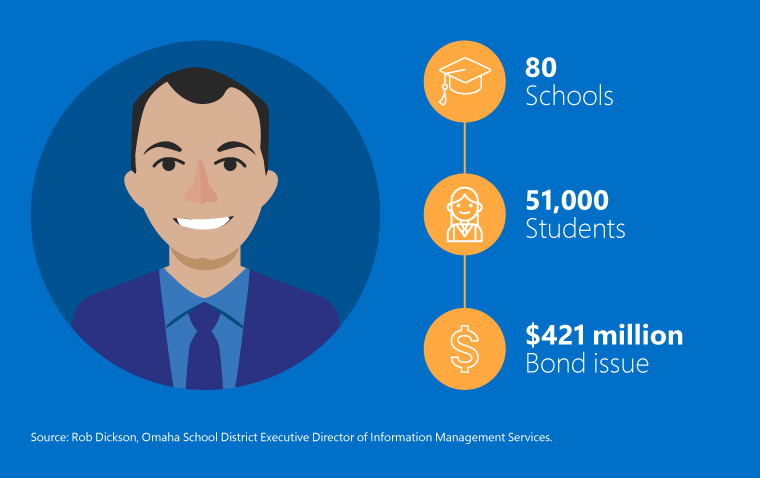
Their limited on-premise data warehousing solution meant they could only passively leverage quantitative data. This lack of flexibility and richness meant dashboard and reports were constantly conflicting, out-of-date, and lacking depth. Dickson realized the the district was at a disadvantage with quantitative data that was not available in real time, and without measurable qualitative data altogether. Dickson looked to transition the district’s data solutions in order to achieve more accurate reporting.
The search for near real-time, holistic dataWith the adoption of Azure and Power BI, Dickson and his team embraced enhanced data warehousing and better insights. The move to a hybrid cloud solution meant growth through a more holistic approach to data acquisition and management.
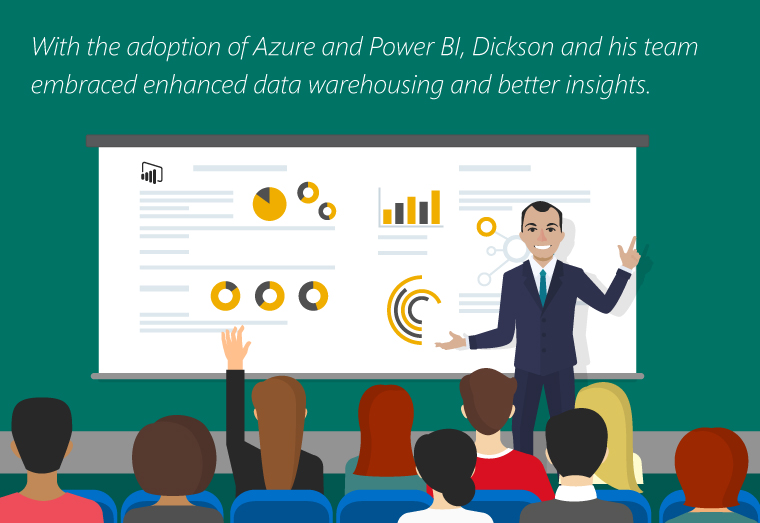
“Power BI is near real-time and helps us put data in the context of what’s happening right now,” says Dickson. “Now we can provide qualitative and quantitative data from the mix of the workload.”
The mix of both qualitative and quantitative analytics through Power BI dashboards and SQL-based SharePoint workflows are driving more organized and meaningful data collection, visualization, and reporting. By creating different Power BI dashboards for different purposes, Dickson and his team were able to provide educators with data on which tools and strategies worked best.
Through these different dashboards, the visualization of finances allowed transparency for the Omaha community, which was a major enhancement for the district. The visibility came from the creation of the App Approval tool through Azure.
“This tool allows teachers to submit instructional technology to be vetted and approved by different committees,” explains Dickson. “If approved, it then goes into a list of apps in a Power BI dashboard. We then go through the list of approved apps and assign them based on instructional strategy. This allows for ongoing evaluation of usage of the app and lets us know when to find something new or to keep using it.”
The App Approval tool means that the district is an open book, which has helped build trust with legislature through availability of institutional and financial information.
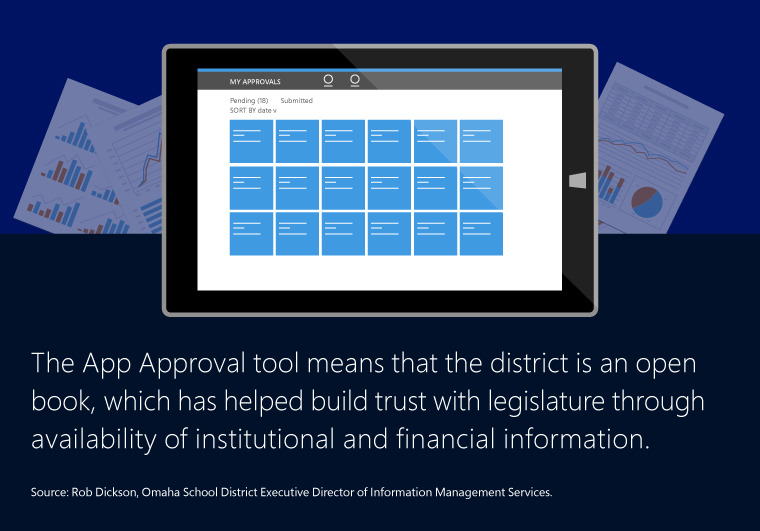
“Anytime you can engage communities and make sure they don’t feel like you’re hiding anything is important,” says Dickson.
By transitioning their data warehousing solutions to Microsoft Azure, OPS found a flexible solution that is equipping administrators with the tools they need to not only access near real-time quantitative reports, but qualitative data as well.
Professional development through better data and coachingDickson didn’t just want to evolve data management and analysis, he also wanted to evolve the classroom.
In order to help streamline operations and increase user adoption, the district’s Microsoft Innovative Educators (MIE) program is running in full force. With 200 educators taking on the role, MIEs are teaching users to work, collaborate, and communicate in the cloud.
The introduction of the MIE program assisted educators in their understanding of the cloud. It’s an organic approach to user adoption, allowing educators to work with their peers to learn and grow.
However, outdated procedures still weighed down teachers’ abilities to be creative in their approach to education. Additionally, it was difficult for educators to drive real change within their classrooms from productive, in-depth feedback.
Before Observation 360’s integration with SharePoint and Power BI, feedback was exclusively pencil and paper. The outdated approach provided little depth for coaches and educators to successfully examine best practices, student needs, and progress.
“We wanted to change the focus of principals from management to instructional leaders,” says Dickson. “We wanted them more often in the classrooms and seeing things happen during learning experiences so they could focus on a strategy based on what they see.”
The district decided to marry SharePoint forms with a Power BI workflow to examine coaching visits. The district was able to look at trends and analysis holistically. They received 23,000 visits in the first year of using the approach and have received 25,000 so far in 2017. As time went on, evolving visualizations of Power BI were more focused on giving coaches feedback.
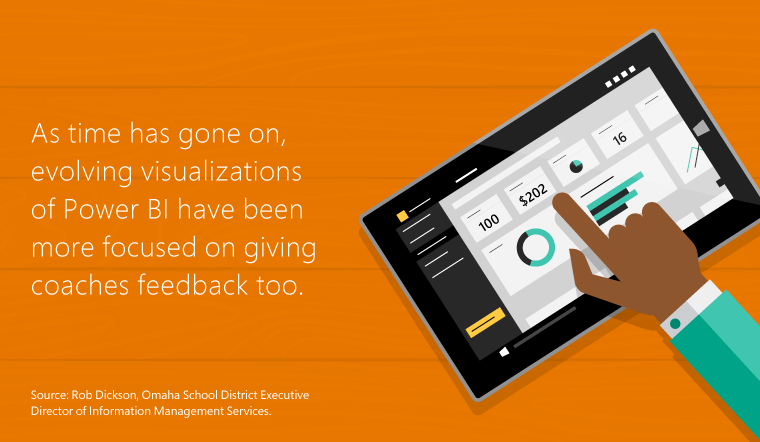
The new approach also allowed coaches to use technology to gather better data. For example, using the Surface to collect video of educators meant that coaches could then load it into the Coaching app to provide instant, clearer feedback that actually captures the teachable moment.
Dickson has been steadily impressed with the depth of feedback as the district has acquired purposeful data through coaching, academic, and behavior dashboards.
“At the time you might not see if a coaching visit aligns to an app with an instructional strategy, but you can look back at the data and see that it does have a correlation, which can then inform your decision making,” says Dickson. “All of these tools work together to effectively see what’s best for the kids.”
A district transformedFor Omaha Public Schools, transforming their data platform has been about transforming teaching and learning by coaching teachers to become better educators and surfacing the best instructional technology. The dashboards and apps they’ve created through innovative, flexible technology guarantees that their new approach aligns with their learning goals.
As Omaha Public Schools continue to gather purposeful data and drive change within their community, they hope to continue expanding through greater user adoption, student caregiver involvement, and implementation of more tech-advanced tools for learning.
“Any of the tools that we’ve implemented—the coaching tool through SharePoint and Power BI, the new app-approval tool—have all been implemented with the mindset that those MIEs will help us increase user adoption,” explains Dickson.
The organic MIE approach along with smarter insights garnered from visualized, holistic Power BI data means that OPS can continue on their journey of digital transformation. The flexibility of the Azure cloud allows versatility well into the future.
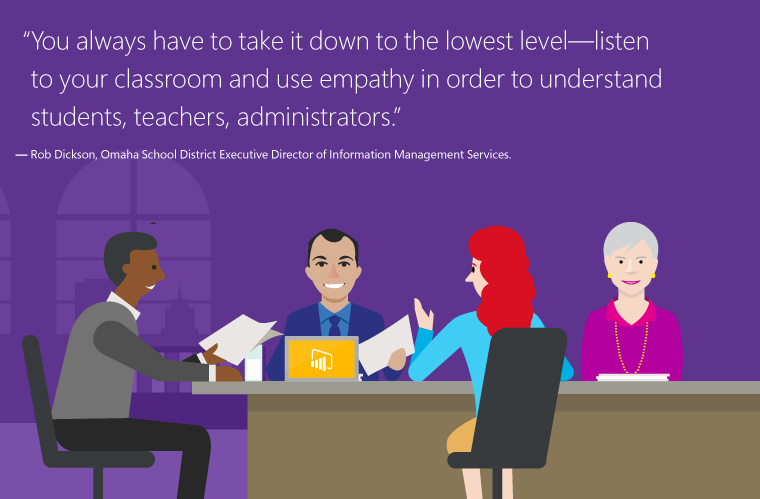
When asked about advice for other school districts looking to go virtual and digitally transform their community, it all comes down to one thing for Dickson: the ability to listen.
“You always have to take it down to the lowest level—listen to your classroom and use empathy in order to understand students, teachers, administrators,” says Dickson. “We are all here for the same reason. If you use all those processes, no matter what size district you are you will see the results.”
Microsoft is proud to partner with Rob Dickson and the Omaha Public Schools as they continue to empower educators and transform data analytics to improve student outcomes.
Related Content
- Read more Real Stories of Digital Transformation
- More on how Omaha Public Schools is transforming education
- Get started with Power BI for free

